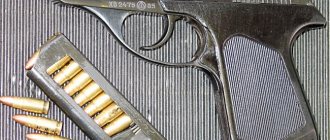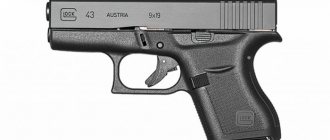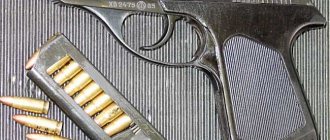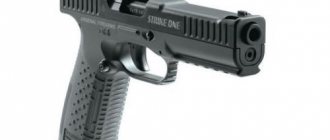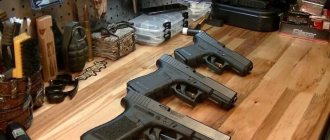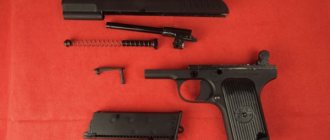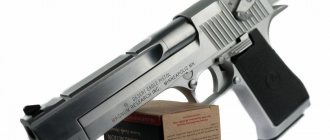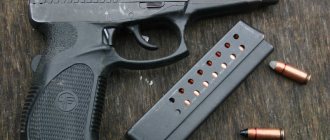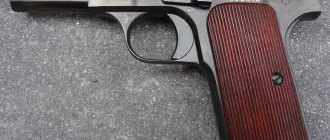1 200
The Austrian Armed Forces have received a new 8.6 mm medium sniper rifle. It complements the range of precision small arms of the Austrian army. The new rifle has a larger caliber and a more powerful scope than the well-known SSG 69 sniper rifle. In 2020, the 8.6 mm rifle began to be supplied to the troops.
In 1969, the Austrian company Steyr Mannlicher developed the SSG 69 sniper rifle, which then entered service with the Austrian ground forces as a sniper weapon. Over the half century since the introduction of SSG 69 in weapons technology, as well as optics, numerous developments have appeared that provide greater accuracy. Thus, the sight is “thinner” (crosshair, etc.), and the magnification factor of the optics is higher than that of the SSG 69. The weapon has become modular and is adjusted to the shooter using an adjustable stock and other components.
Another aspect that is increasingly coming to the fore is firing range. The new 8.6 mm Steyr 08A2 medium sniper rifle (mSSG), also designated Steyr MSSG M1 for civilian use, increases the firing range compared to the SSG 69 from 800 m to 1200 m (plus 50 percent).
Medium sniper rifle mSSG
Export of pistols from Russia, Kazakhstan, Belarus
We will help promote pistols) in Austria. We work only with companies.
- Only direct manufacturer: plant, factory, production
- It is possible to advise on the specifics of your product
- Production of large quantities of goods
- ❌Intermediaries
- ❌We do not work with retail
- ❌Individual
We provide services:
- Advertising in Austria
- Market analysis
- Participation in exhibitions
- Targeted mailings to target audience
Glock, striptease and Die Hard
Sometimes, not the most successful weapons are adopted due to the efforts of marketers, the lobbying capabilities of manufacturing companies, or for the sake of the political situation, and a good rifle or machine gun can lose a competition due to incorrectly executed papers. Even future bestsellers on the arms market often have to go to success in a roundabout way - for example, the Austrian Glock, which today is considered almost the standard of a modern pistol, paved the way to the American market through... striptease bars.
At the end of last year it became known that the French army would adopt German HK416 assault rifles instead of its own FAMAS, the production of which had been discontinued. Heckler&Koch (Germany), FN Herstal (Belgium), Beretta (Italy), Swiss Arms (Switzerland) and HS Produkt (Croatia) fought for the right to arm the French. The HK416 from Heckler&Koch and the Belgian FN SCAR reached the finals of the competition. As a result, the contract worth millions of euros went to the Germans. Later it turned out that the FN SCAR was not allowed to the final tests due to the fact that the Belgians submitted incorrect documentation, that is, on purely “paper” grounds - such information was in French sources.
It is not a fact that it was errors with the execution of the contract that became the reason for the removal of FN Herstal from the competition; there may also be a political background: the French closely cooperate with Germany in the military sphere and have a number of joint military projects. For example, the creation of a united tank-building concern or the long-suffering Tiger attack helicopter project. And problems with the execution of the FN Herstal contract may be a way to save face for all participants in this story.
FAMAS rifle
Shot: Daily Military Defense & Archive / YouTube
1/3
One of the most striking examples of brilliant marketing work is the success of the Glock pistol. In 1982, the Austrian army adopted a pistol from the little-known company Glock GmbH, which previously produced knives and military blades. The owner of the company, Gaston Glock, decided to create a simple, reliable and very cheap pistol - a team was specially assembled for this purpose, which included army officers and former designers of the Austrian company Steyr. Using experience from working on the Steyr AUG assault rifle and the NK VP-70 pistol, Glock engineers developed a prototype with a minimum of parts, does not require expensive manufacturing operations and is almost half made of plastic.
The low cost, high reliability and service life of the Glock 17 (that was the name of the sample) helped him win the Austrian competition. And then the task was to conquer the bottomless American market, where several million guns are sold every year in the civilian segment alone.
Since 1994, the Americans themselves have unsuccessfully tried to replace the Beretta 92 pistol in service - massive, heavy, not very convenient, and also having problems with the reliability and service life of individual components. But all attempts to dismiss the Italian failed - Beretta had enough influence to freeze this process. “There were a lot of arguments: production in the United States, an established repair and maintenance system, etc.,” explains Mikhail Degtyarev, editor-in-chief of Kalashnikov magazine.
Plus, the list of requirements for a potential successor to Beretta was very large (about 80 pages of text) and contradictory. “Instead of taking the best samples available on the market, testing them and choosing the most suitable one, someone came up with a huge number of complex requirements, it is unclear where they come from, it is unclear how they are justified. It was almost impossible to satisfy them,” weapons historian Maxim Popenker told Lenta.ru.
Glock 17 pistol
Photo: Ralph Orlowski/Reuters
1/3
Glock marketers did not knock on the doors of the Ministry of Defense, but took civilians, police and special forces into circulation.
The relative cheapness of the Austrian pistol allowed American Glock distributors to pursue an aggressive pricing policy and offer their customers “buy back” programs, when the supplier company, when selling a new weapon, simultaneously buys back the client’s old barrel. This relieved the headaches of the heads of police departments about how to get rid of old stuff and update the arsenal on a limited budget. According to The New York Times, Glock representatives did not hesitate to organize buffets, entertainment events, and even sponsored visits to strip clubs for the heads of police departments.
Experts and journalists believe that various myths associated with the Glock (for example, that it cannot be detected by metal detectors) were also part of the advertising campaign. Here's the famous line from John McClane, the main character in Die Hard: "That idiot had a Glock, a German porcelain gun that doesn't catch metal detectors and costs more than your monthly salary." Everything here is not true: Glock is an Austrian pistol, there is no porcelain in it, it is cheap and is easily caught by metal detectors. The latter was proven by Gaston Glock himself, walking through a metal detector with a pistol in front of American military officials.
But the main thing is to start a rumor, Maxim Popenker is sure: “It was a brilliant move from an advertising point of view. Of course, there is no confirmation that this text was written by a Glock representative, it looks like a simple film blooper, but it worked absolutely perfectly. The film is popular, many people are wondering - what is this thing? We started reading magazines and looking for information about the gun.”
The result was what is commonly called an epic win: Glock conquered the American civilian market, was adopted by police units, and the Main Directorate of Special Forces of the US Department of Defense (SOCOM) purchased about 100 thousand Glocks with its own money and without any competitions. The Austrian has become a kind of symbol of the modern pistol, and many famous companies today produce their own models “like Glock.”
However, the lobbying of large manufacturers in the United States opened the way to army arsenals - just remember the history of the famous M16 rifle.
The American military did not really like the AR15/M16, created by ArmaLite and purchased by Colt. The generals lobbied for the adoption of the M14 automatic rifle, which was produced by the state arsenal in Springfield (however, there were also many complaints about it, and its production was curtailed in 1964). There were even rumors that army officials manipulated test results to prove the failure of the M16.
US Marines with M16 rifles
Photo: HighInBC /
1/2
Then Colt came in through the back door. This is how Maxim Popenker describes it: “The command of the strategic forces of the US Air Force needed small arms to protect its nuclear bombers - the carbines in service were becoming obsolete. Colt representatives, who had a good relationship with their commander, General LeMay, gave a demonstration of the new AP15s, showed how beautifully they smashed watermelons, and the general ordered several thousand rifles for air base security without any formal testing."
Then there was the story of the one-time purchase of 85 thousand M16s for American units in Vietnam and the ensuing scandal: it turned out that the rifles jammed because Colt saved on chrome plating of parts, improper gunpowder was used in the cartridges, and the soldiers were not given tools for cleaning weapons.
After a trial in Congress, the shortcomings were corrected, and the performance characteristics were brought to an acceptable level. The M16 rifle remained in the army, and no matter how hard they tried to find a replacement for it, nothing worked. Only full-size rifles replaced the M4 carbines.
By the way, with the help of the M16, Mikhail Degtyarev believes, the Americans practically buried the promising Israeli Galil project. During the Arab-Israeli wars, the States supplied Tel Aviv with large quantities of their rifles at prices below the cost of the Galil (due to the milled receiver, the Israeli assault rifle was quite expensive). Soon the Israel Defense Forces switched from Galil to M16 and their shortened variants CAR15, and the production of their own machine guns was practically curtailed.
Many Israeli military personnel were not too happy about the replacement. “When we are in the sand, when we are in the water, when we are in the mud, the weapon often jams. The soldiers went into battle and were not sure that the weapon would work,” Mikey Hartman, the former head of shooting and sniper training in the Israeli army, said in one of his interviews. Indirect confirmation can be the fact that the IDF still uses the M16/M4, the Galil, and the new TAR-21 Tavor.
“In my opinion, we were faced with the foresight of the Americans, who sensed the potential of Galil and nipped it in the bud,” says Mikhail Degtyarev. “I assume (I emphasize this is an assumption) that one of the tasks was not just to sell rifles to Israel, but not to allow the Israelis to develop the Galil theme, because the potential of the product from the point of view of the world market was very large.” Galil rifles are still produced in Israel and are even exported, but the market opportunities of the model withdrawn from service are several times lower.
American gun enthusiasts have a joke that, when translated, goes something like this: “How to spell Heckler & Koch? - Expensive".
It is believed that the company's products are distinguished by a high price and appropriate quality. But over the past few years, there have been reports in the German press that the Bundeswehr is trying to sue Heckler & Koch. The cause of the conflict is the G36 rifle in service with the army. “Even 10-15 years ago, I came across the opinion of German gunsmith experts about the G36, which was expressed in one word: crap,” recalls the editor-in-chief of Kalashnikov.
When put into service (1997), the new machine gun corresponded to the ideas about weapons of the 21st century: futuristic design, widespread use of plastic, modularity, and the use of an sighting system consisting of a collimator and optical sights.
American soldiers with HK G36 rifles
Photo: US Army/
1/2
There were complaints about the G36 before, but there were especially many of them during the war in Afghanistan. In the spring of 2012, reports emerged of German soldiers complaining that their rifles were overheating during prolonged shooting. Der Spiegel wrote that the command of German military operations in Afghanistan ordered military personnel to be sure to cool their machine guns. Allegedly, due to overheating, accuracy when shooting at 300 meters decreased by a third (there was information that the effective range dropped to almost 200 meters), the risk of delays and the risk of burns increased.
It has been suggested more than once that the G36 was adopted taking into account the lobbying capabilities of Heckler & Koch. By the way, according to Maxim Popenker, American users often describe NK products as “expensive weapons made using cheap technologies.”
The scandal with G36 overheating seems to have been hushed up - there were even reports in the press that it was not the weapon that was to blame, but low-quality cartridges. Although experts consider this to be the company’s work to minimize damage.
It is worth noting that in the early 2000s, Heckler & Koch developed a shooting system for the Americans, which was supposed to replace the M4 carbines currently in service. The weapon was called XM8 and was essentially a G36, only with an even more space-age design. It was assumed that the rifle would begin to enter service in 2006, but the project was closed in 2005.
Factories and wholesale manufacturers from Austria
- Pneumatic hand tools: pistol, “RAMSAUER GMBH&CO KG” (AUSTRIA)
- Mechanized hand tools: mounting gun, Hilti Austria GesmbH (AUSTRIA)
- Mechanized hand tools: mounting gun, Hilti Austria GesmbH (AUSTRIA)
- Mechanized hand tools: mounting construction gun Hilti Austria GesmbH (AUSTRIA)
Suppliers from Austria
When purchasing in bulk, you need to choose the right production in Austria, where on the one hand the price is lower, but on the other hand you can save on delivery or directly to Moscow, Kazan or St. Petersburg.
| Manufacturer / Product | Brand / Verified |
| “PC COX LTD”, “SIKA” / MANUAL GUN, NON-NEUMATIC, MADE OF STEEL FOR UNIFORM APPLICATION OF SEALANT WHEN BONDING PLASTIC SURFACES, DESIGNED FOR COMPOSITION | "SIKA" |
| HILTI CORPORATION LTD, HILTI / PNEUMATIC HAND TOOLS: GAS (PNEUMATIC) INSTALLATION GUN GX 120. SUPPLIED IN AN IMPACT-RESISTANT PLASTIC CASE., INCLUDED: SUPPORT |
We can help you become an official pistol distributor
Weapon system
The mSSG Steyr 08A2 is a modern sniper rifle, adaptable by changing the overall length, adjusting the travel and force of the trigger, its longitudinal position and changing the position of the handle according to the needs of the shooter. The total length of the weapon with the butt extended is 133 cm, with the muzzle brake installed - 145 cm. If the butt is folded to the right, for example, for transportation, the total length is reduced to 108 cm.
Performance characteristics of a sniper rifle
The mSSG Steyr 08A2 8.6 mm medium sniper rifle is a bolt-action repeating rifle. The barrel length is 69 cm, or 27 inches, with a constant right-hand rifling of the bore to stabilize the bullet and for high-precision target destruction up to at least 1,200 m. The muzzle velocity of the bullet reaches 889 m/s. Maximum set firing range: 5,700 m. Ammunition is fed from a metal magazine with a capacity of 10 rounds. The weight of the mSSG with the ZF624i scope and loaded magazine is approximately 9.25 kg. The weight is optimal to ensure stable and accurate shooting.
Receiver with Picatinny rail and Key Mod system
The mSSG Steyr 08A2 sniper rifle has a long barrel lining, which is equipped with a Picatinny rail on the top surface and a Key Mod mounting system on the side surface. These mounting options allow you to install various accessories such as night vision, thermal imaging or laser designator.
Another accessory that is mounted on the stock is the ground rest, which allows the shooter to place the weapon on the ground and point it at the target. This is useful if the sniper must wait a long time for the target or if the weapon must be held at the shoulder. As a result, the rifle always remains stable, making it much easier to aim at the target. However, this does not replace the standard pads (bags of sand or granules) that snipers use. In addition to the Picatinny rail and Key Mod system, you can attach a bipod or tripod.
Ground support on the butt
The mSSG safety is installed in two ways: the safety lever and the safety wheel. The fuse offers three positions: “unblocked”, “charged”, “on safety”. To reduce shot signatures, a muzzle damper-flash suppressor is used. It can quickly attach to the muzzle brake and relieve the thermal effect with a thermal cap.
Table 1
Tactical and technical characteristics of the mSSG Steyr 08A2 sniper rifle
| Parameter | Characteristic |
| Caliber | 8.6x70 mm (.338 Lapua Magnum) |
| Weight with external magazine and optical sight | approx. 9.25 kg |
| Length with flame arrester | 140 – 145 cm |
| Length with stock folded | 108 cm |
| Barrel length | 69 cm |
Delivery and customs clearance of pistols from Austria
We have selected reliable and trusted companies for delivery from Austria to the Russian Federation (Moscow, St. Petersburg, Kazan and other cities of the Russian Federation). Direct deliveries with suppliers: cargo delivery and customs clearance.
- ✅ BuroImporta LLC - website https://buroimporta.ru tel. 8 (499) 348-29-89 mail:
- ✅ ImportR LLC - website https://import-v-rossiu.ru tel. +7(499) 322-98-16 mail:
- ✅ Delivery Asia (Air transportation only) - website https://dostavka-asia.ru tel. mail:
- ⁉️Would you like us to add your organization? Write to us by email
The cost of selecting manufacturers who produce/produce goods in one country will be 7,990 rubles.
Medium Sniper Rifle: Caliber
At the international level, there is a transition from the previously used 7.62x51 mm NATO (.308) ammunition to 8.6x70 mm Lapua (.338). The Lapua Magnum caliber 8.6x70 mm is characterized by minimal deflection and braking from wind and air resistance. Ammunition of this caliber is distinguished by very precise manufacturing, which at long distances allows for a smaller dispersion circle. Candidate snipers, when shooting from the new mSSG 08A2, already during the acceptance tests, in order to gain access to training, achieve a scattering circle diameter of a maximum of three centimeters per 100 m.
Comparison of calibers 7.62 and 8.6 mm
Currently, the 8.6x70 mm Lapua Magnum caliber is actively used by operational units around the world for “long ranges” (more than 1000 m). In addition, there is a wide range of ammunition types available in this caliber used internationally: armour-piercing, glass-piercing or full-jacketed. Having a choice of ammunition allows the sniper to be more successful in a variety of scenarios.
